A New Dual Stator Permanent Magnet Machine Based on Field Modulation Theory
Abstract
:1. Introduction
2. Topology and Operating Principle
2.1. Topology
2.2. Operating Principle
2.3. Key Parameters Design
3. Electromagnetic Performance Analysis
3.1. No-Load Airgap Flux Density
3.2. No-Load Magnetic Field Distribution
3.3. No-Load Back-EMF
3.4. Torque Characteristics
3.5. Power Factor and Efficiency
4. Conclusions
Author Contributions
Funding
Institutional Review Board Statement
Informed Consent Statement
Data Availability Statement
Conflicts of Interest
References
- Zhu, Z.Q.; Howe, D. Electrical machines and drives for electric, hybrid and fuel cell vehicles. Proc. IEEE 2007, 95, 746–765. [Google Scholar] [CrossRef]
- Chau, K.T.; Chan, C.C.; Liu, C. Overview of permanent-magnet brushless drives for electric and hybrid electric vehicles. IEEE Trans. Ind. Electron. 2008, 55, 2246–2257. [Google Scholar] [CrossRef] [Green Version]
- Boldea, I.; Tutelea, L.; Parsa, L.; Dorrell, D. Automotive electric propulsion systems with reduced or no permanent magnets: An overview. IEEE Trans. Ind. Electron. 2014, 61, 5696–5711. [Google Scholar] [CrossRef]
- Li, D.; Zou, T.; Qu, R.; Jiang, D. Analysis of fractional-slot concentrated winding PM vernier machines with regular open-slot stators. IEEE Trans. Ind. Appl. 2018, 54, 1320–1330. [Google Scholar] [CrossRef]
- Kim, B.; Lipo, T.A. Analysis of a PM vernier motor with spoke structure. IEEE Trans. Ind. Appl. 2016, 52, 217–225. [Google Scholar] [CrossRef]
- Li, X.; Chau, K.T.; Cheng, M. Comparative analysis and experimental verification of an effective permanent-magnet vernier machine. IEEE Trans. Magn. 2015, 51, 1–9. [Google Scholar]
- Zhu, X.; Lee, C.H.T.; Chan, C.C. Overview of flux-modulation machines based on flux-modulation principle: Topology, theory, and development prospects. IEEE Trans. Transp. Electrif. 2020, 6, 612–624. [Google Scholar] [CrossRef]
- Cheng, M.; Han, P.; Hua, W. General airgap field modulation theory for electrical machines. IEEE Trans. Ind. Electron. 2017, 64, 6063–6074. [Google Scholar] [CrossRef]
- Kwon, J.; Kwon, B. Investigation of dual-stator spoke-type vernier machine for EV application. IEEE Trans. Magn. 2018, 54, 1–5. [Google Scholar] [CrossRef]
- Jia, S.; Qu, R.; Li, J.; Li, D.; Kong, W. A stator-PM consequent-pole vernier machine with hybrid excitation and DC-biased sinusoidal current. IEEE Trans. Magn. 2017, 53, 1–5. [Google Scholar] [CrossRef]
- Zhang, H.; Kou, B.; Zhu, Z.Q.; Qu, R.; Luo, J.; Shao, Y. Thrust ripple analysis on toroidal-winding linear permanent magnet vernier machine. IEEE Trans. Ind. Electron. 2018, 65, 9853–9862. [Google Scholar] [CrossRef]
- Wang, H.; Fang, S.; Jahns, T.M.; Yang, H.; Lin, H. Design and analysis of a dual-rotor field modulation machine with triple PM excitation. In Proceedings of the 2018 IEEE Energy Conversion Congress and Exposition, Portland, OR, USA, 23–27 September 2018; pp. 3302–3309. [Google Scholar]
- Fang, H.; Wei, Y.; Song, R. Design and analysis of superconducting magnetic-field-modulation electric machine. IEEE Trans. Appl. Supercond. 2021, 31, 1–4. [Google Scholar] [CrossRef]
- Wang, H.; Fang, S.; Yang, H.; Lin, H.; Wang, D.; Li, Y.; Jiu, C. A novel consequent-pole hybrid excited vernier machine. IEEE Trans. Magn. 2017, 53, 1–5. [Google Scholar] [CrossRef]
- Yang, H.; Lin, H.; Zhu, Z.Q.; Lyu, S.; Liu, Y. Design and analysis of novel asymmetric-stator-pole flux reversal PM machine. IEEE Trans. Ind. Electron. 2020, 67, 101–114. [Google Scholar] [CrossRef] [Green Version]
- Tan, Q.; Wang, M.; Li, L. Analysis of a new flux switching permanent magnet linear machine. IEEE Trans. Magn. 2021, 57, 1–5. [Google Scholar] [CrossRef]
- More, D.S.; Fernandes, B.G. Analysis of flux-reversal machine based on fictitious electrical gear. IEEE Trans. Energy Convers. 2010, 25, 940–947. [Google Scholar] [CrossRef]
- Jin, M.J.; Wang, Y.; Shen, J.X. Cogging torque suppression in a permanent magnet flux-switching integrated-starter-generator. IET Electr. Power Appl. 2010, 4, 647–656. [Google Scholar] [CrossRef] [Green Version]
- Zhu, X.; Hua, W. Stator-slot/rotor-pole pair combinations of flux-reversal permanent magnet machine. IEEE Trans. Ind. Electron. 2019, 66, 6799–6810. [Google Scholar] [CrossRef]
- Hua, H.; Zhu, Z.Q. Novel hybrid-excited switched-flux machine having separate field winding stator. IEEE Trans. Magn. 2016, 52, 1–5. [Google Scholar] [CrossRef]
- Baloch, N.; Kwon, B.; Gao, Y. Low-cost high-torque-density dual-stator consequent-pole permanent magnet vernier machine. IEEE Trans. Magn. 2018, 54, 1–5. [Google Scholar] [CrossRef]
- Shi, Y.; Ching, T.W. Power factor analysis of dual-stator permanent magnet vernier motor with consideration on turn-number assignment of inner and outer stator windings. IEEE Trans. Magn. 2021, 57, 1–5. [Google Scholar] [CrossRef]
- Bilal, M.; Ikram, J. Performance improvement of dual stator axial flux spoke type permanent magnet vernier machine. IEEE Access 2021, 9, 64179–64188. [Google Scholar] [CrossRef]
- Wei, L.; Nakamura, T. Optimization design of a dual-stator switched flux consequent pole permanent magnet machine with unequal length teeth. IEEE Trans. Magn. 2020, 56, 1–5. [Google Scholar] [CrossRef]
- Li, Y.; Bobba, D.; Sarlioglu, B. Design and performance characterization of a novel low-pole dual-stator flux-switching permanent magnet machine for traction application. IEEE Trans. Ind. Appl. 2016, 52, 4304–4314. [Google Scholar] [CrossRef]
- Kim, D.; Hwang, H.; Bae, S. Analysis and design of a double-stator flux-switching permanent magnet machine using ferrite magnet in hybrid electric vehicles. IEEE Trans. Magn. 2016, 52, 1–4. [Google Scholar] [CrossRef]
- Wang, H.; Fang, S. Design of new dual-stator field modulation machines. IEEE Trans. Ind. Electron. 2020, 67, 5626–5636. [Google Scholar] [CrossRef]
- Asgar, M.; Afjei, E.; Torkaman, H. A new strategy for design and analysis of a double-stator switched reluctance motor: Electro-magnetics, FEM, and experiment. IEEE Trans. Magn. 2015, 51, 1–8. [Google Scholar] [CrossRef]
- Chai, F.; Pei, Y.; Zheng, P. Analysis and restrain strategy of cogging torque in double-stator permanent magnet brushless motor. In Proceedings of the IEEE International Electric Machines and Drives Conference, Madison, WI, USA, 1–4 June 2003; Volume 2, pp. 1073–1077. [Google Scholar]
- Chai, F.; Xia, J.; Guo, B. Double-stator permanent magnet synchronous in-wheel motor for hybrid electric drive system. IEEE Trans. Magn. 2009, 45, 278–281. [Google Scholar] [CrossRef]
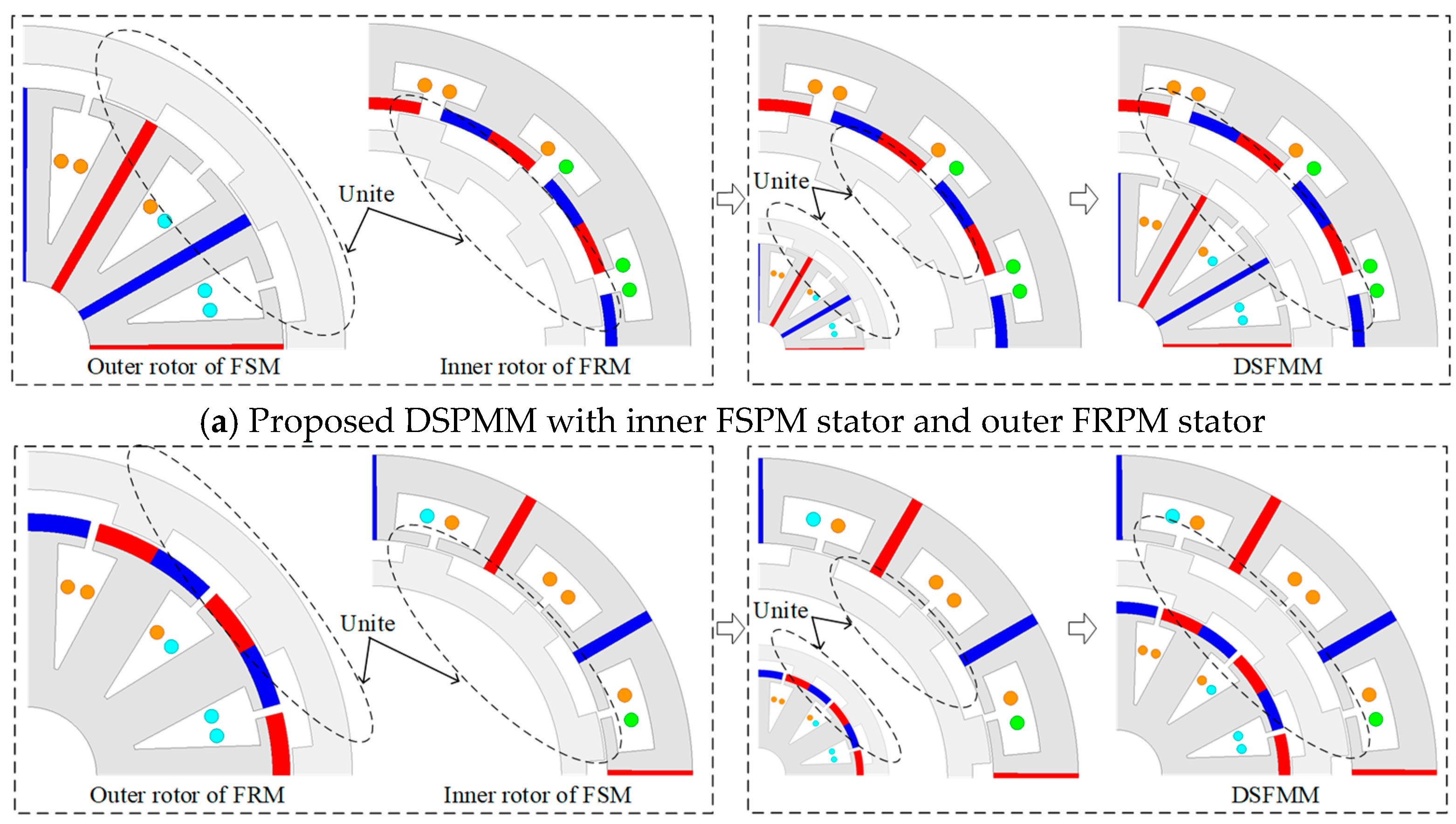

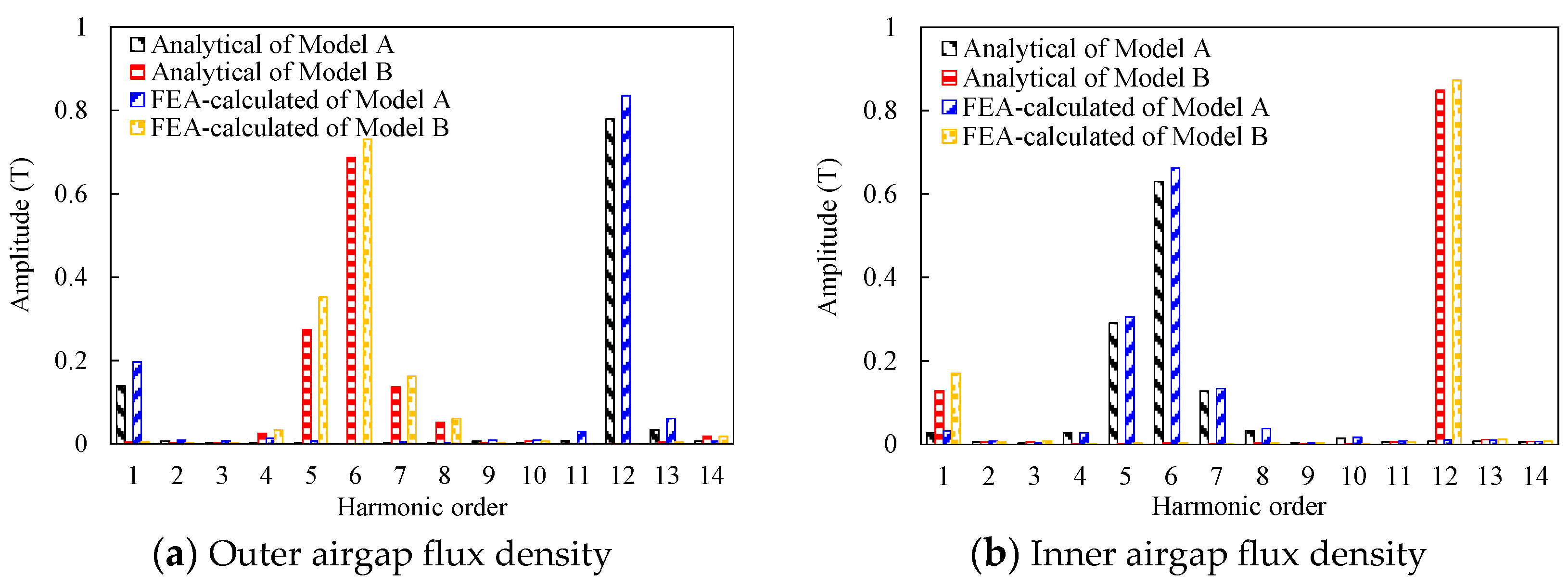
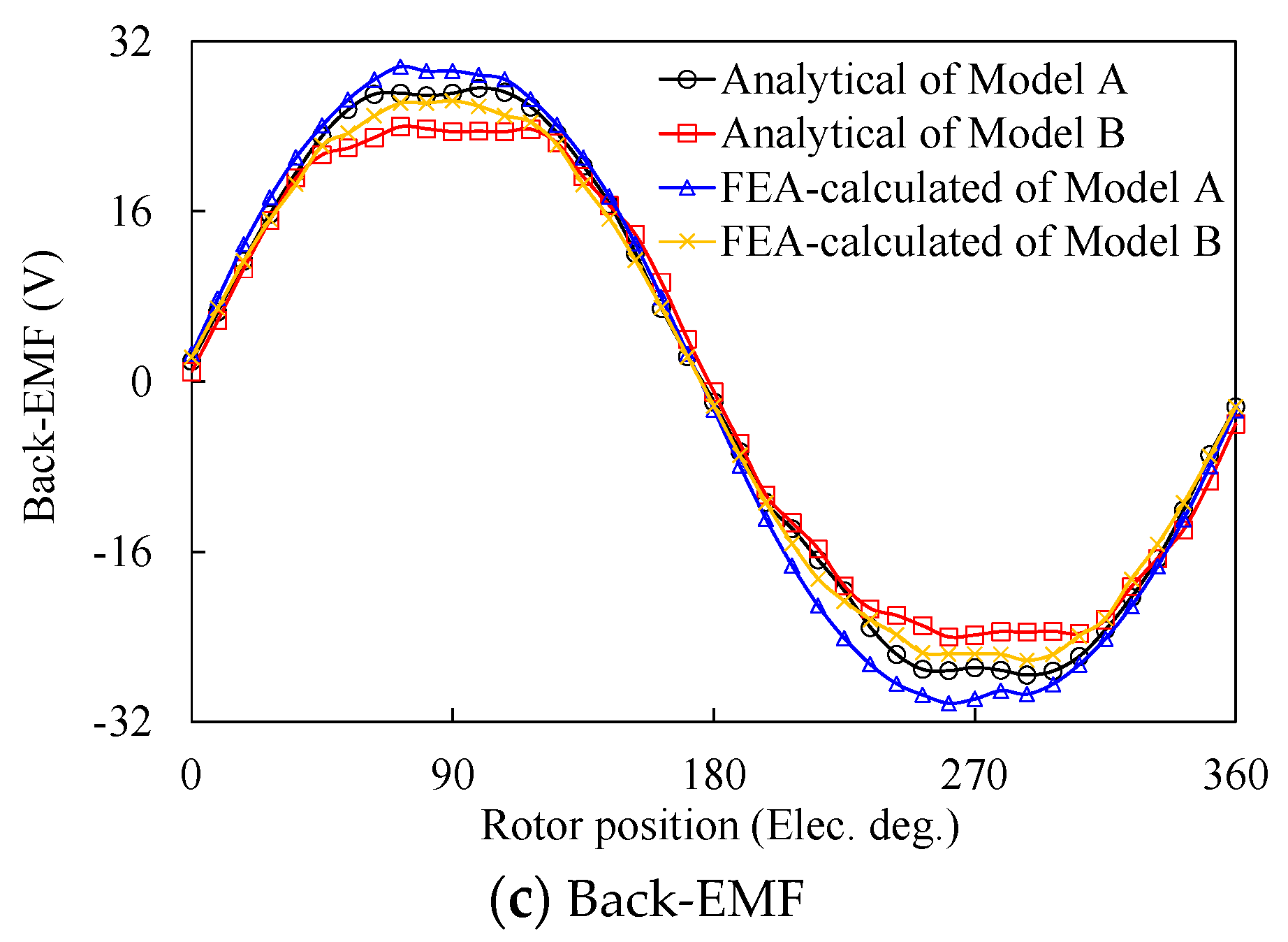
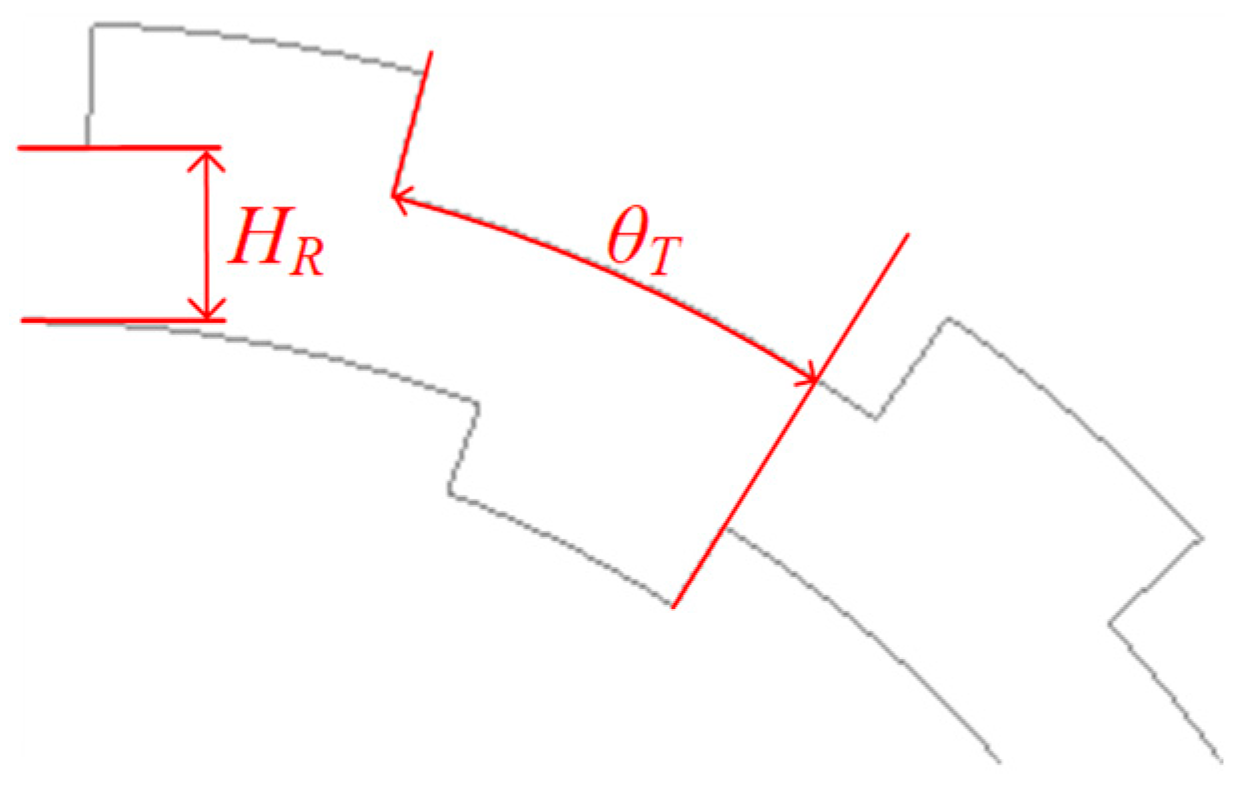
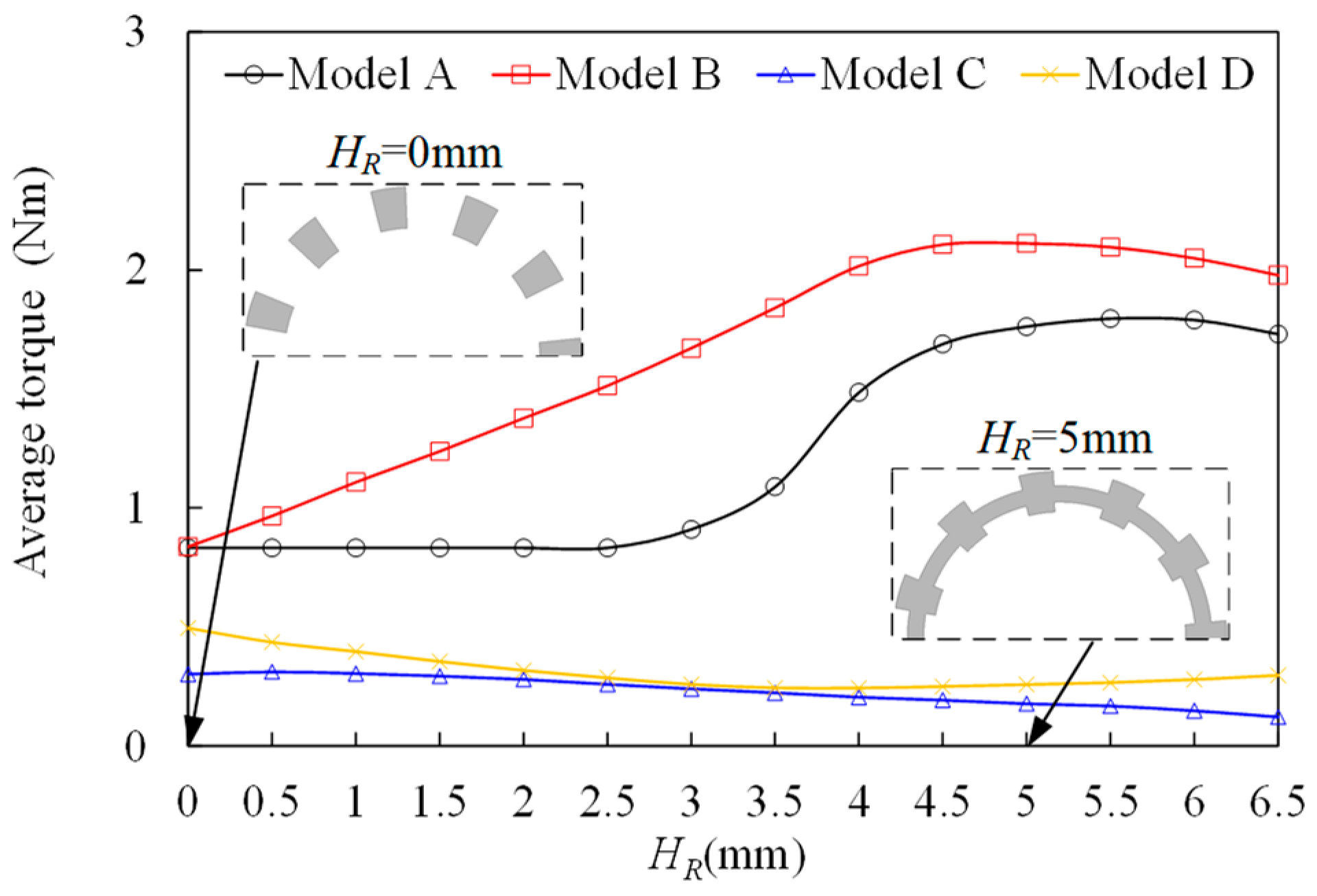
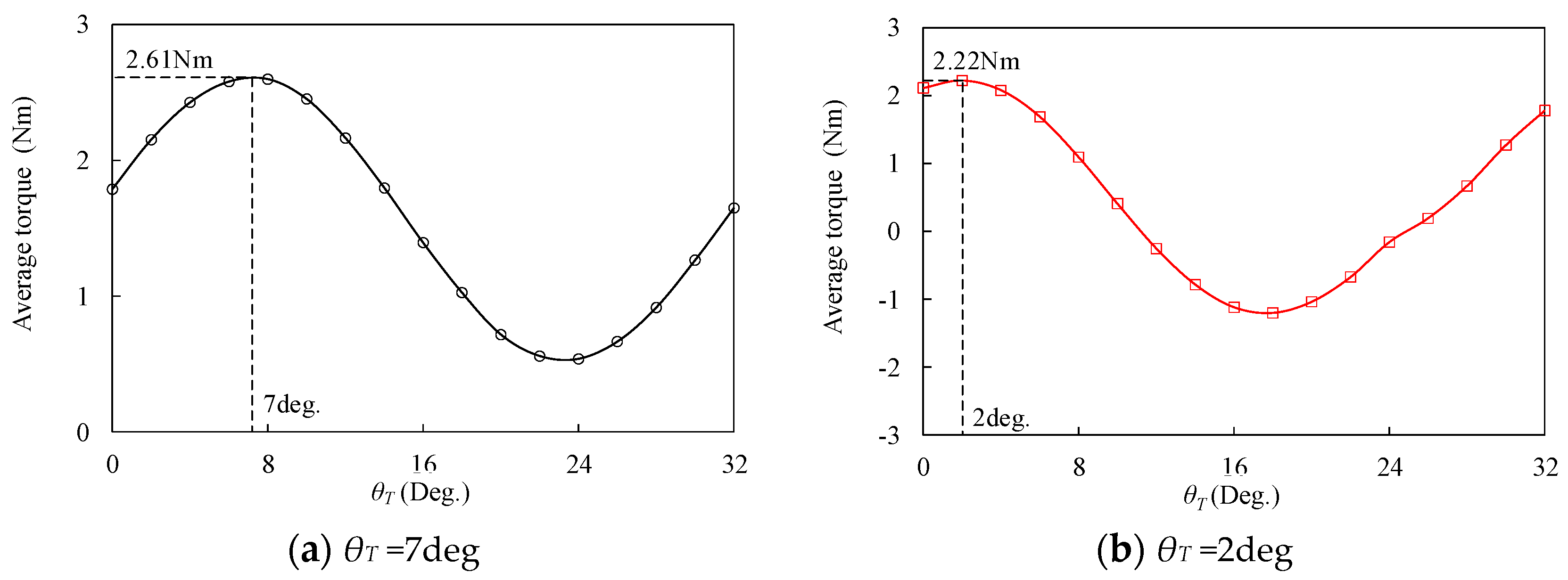
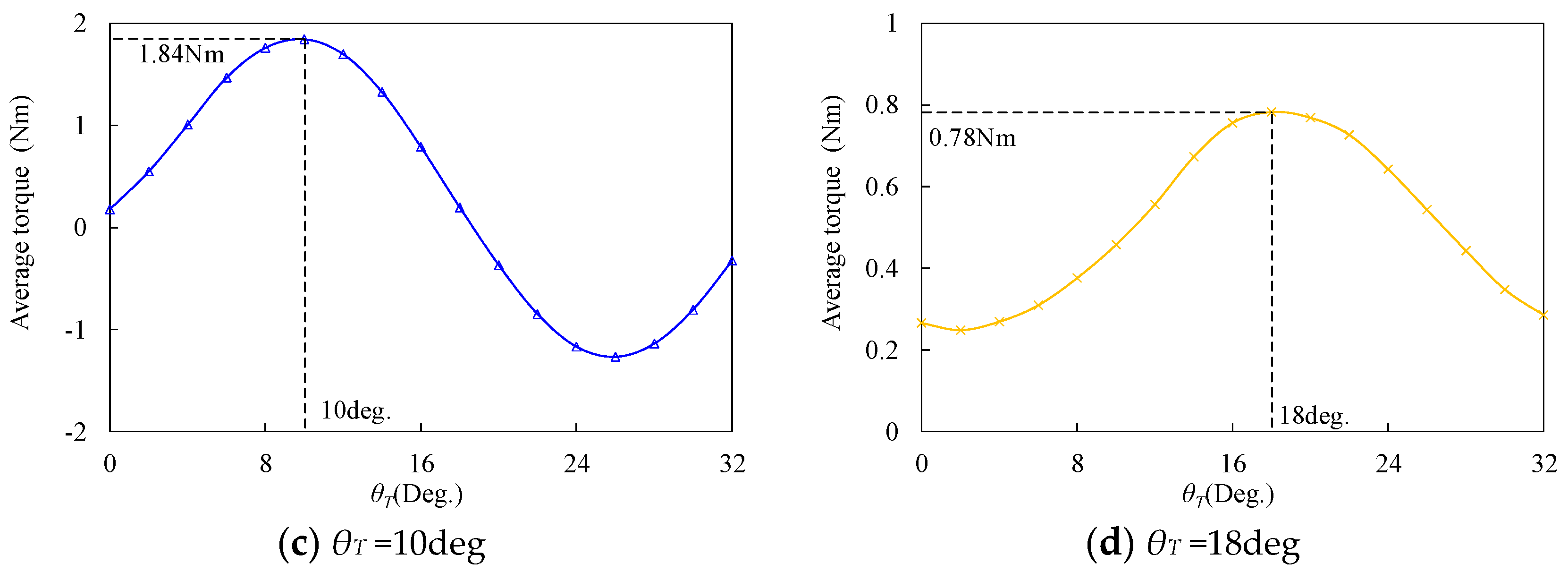
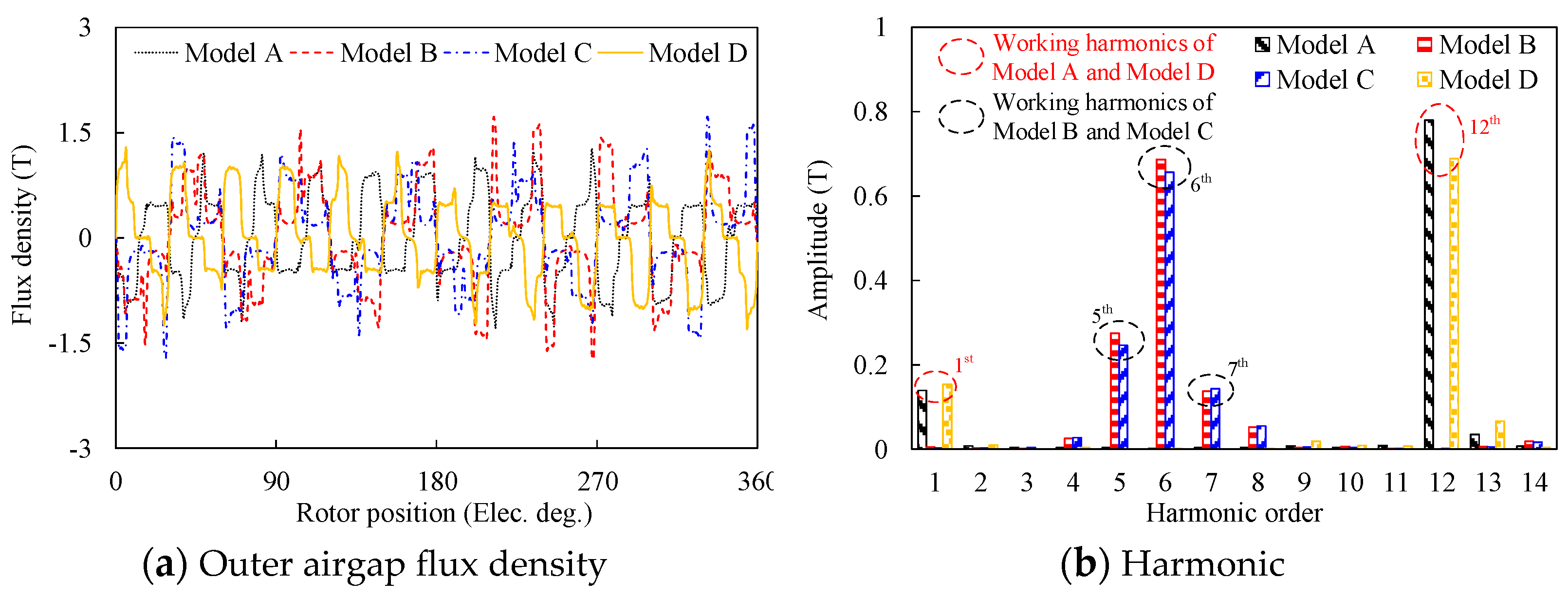
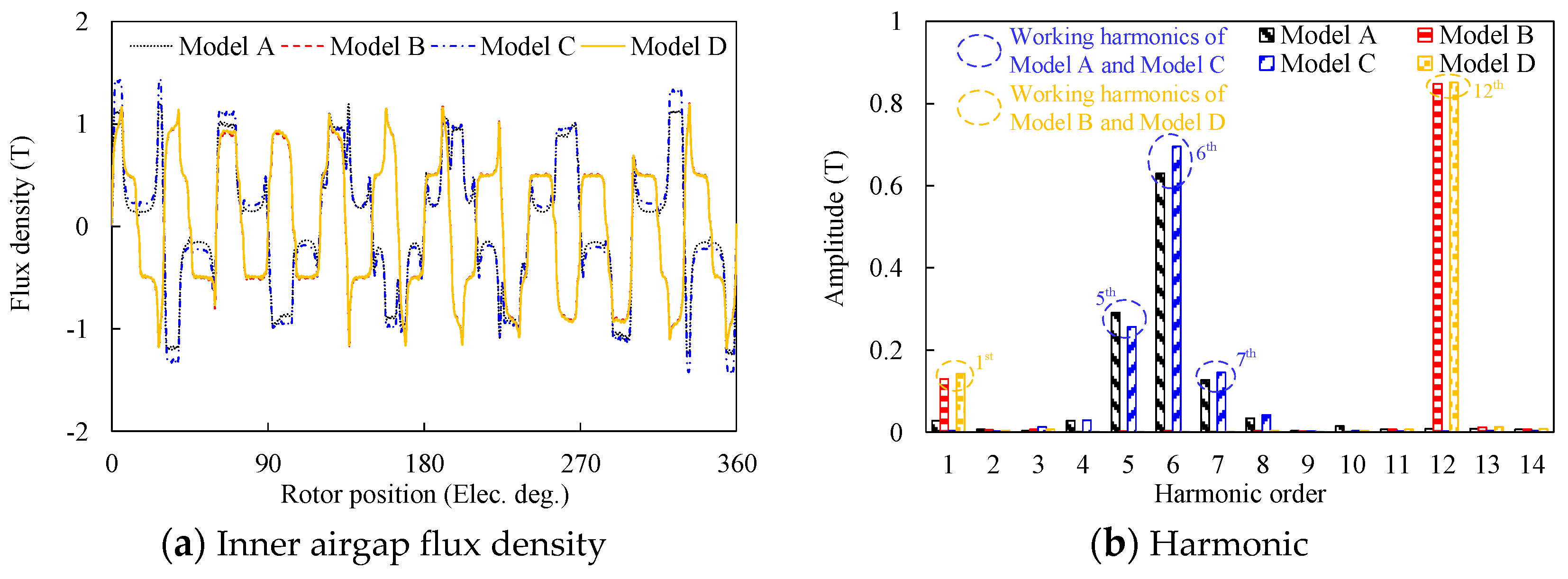
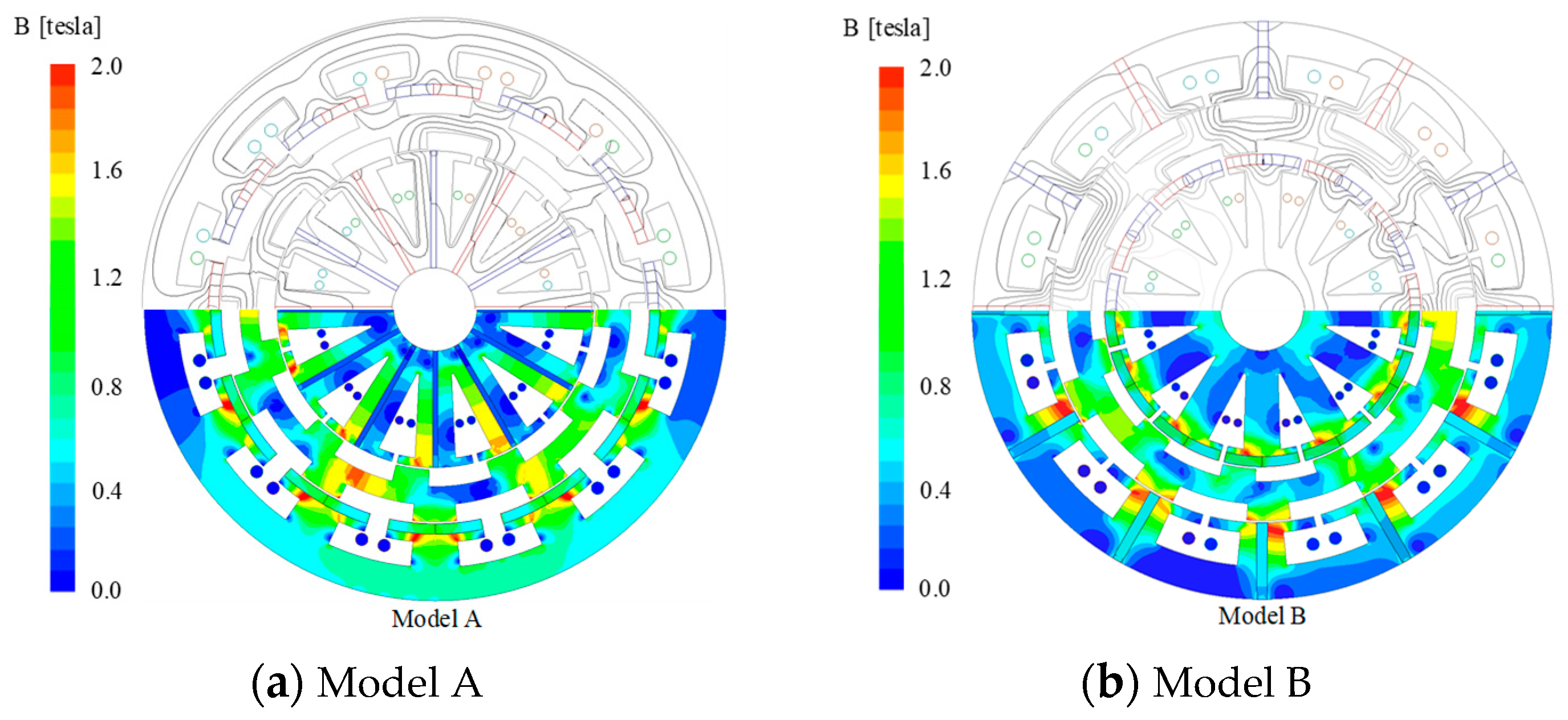
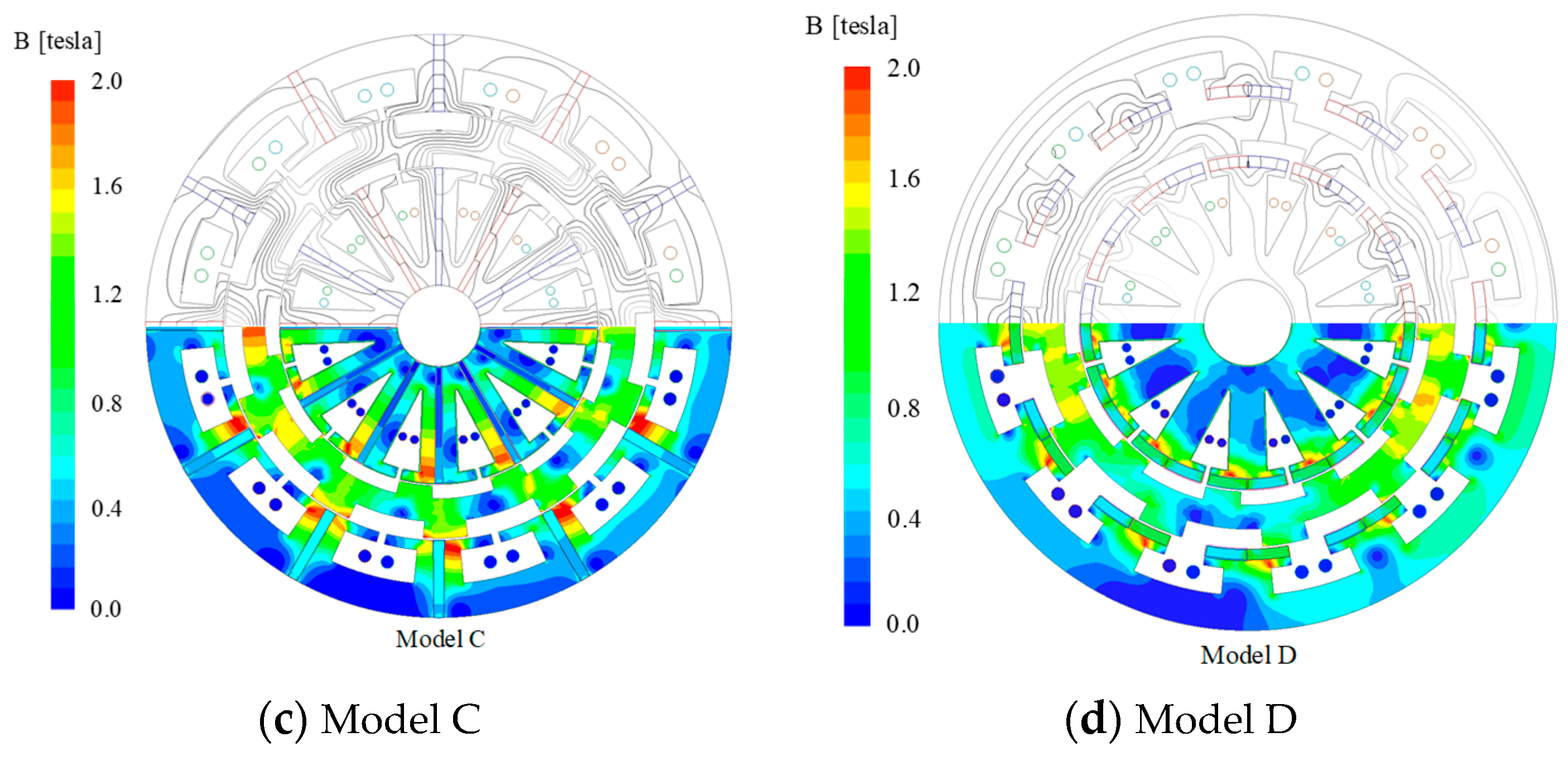
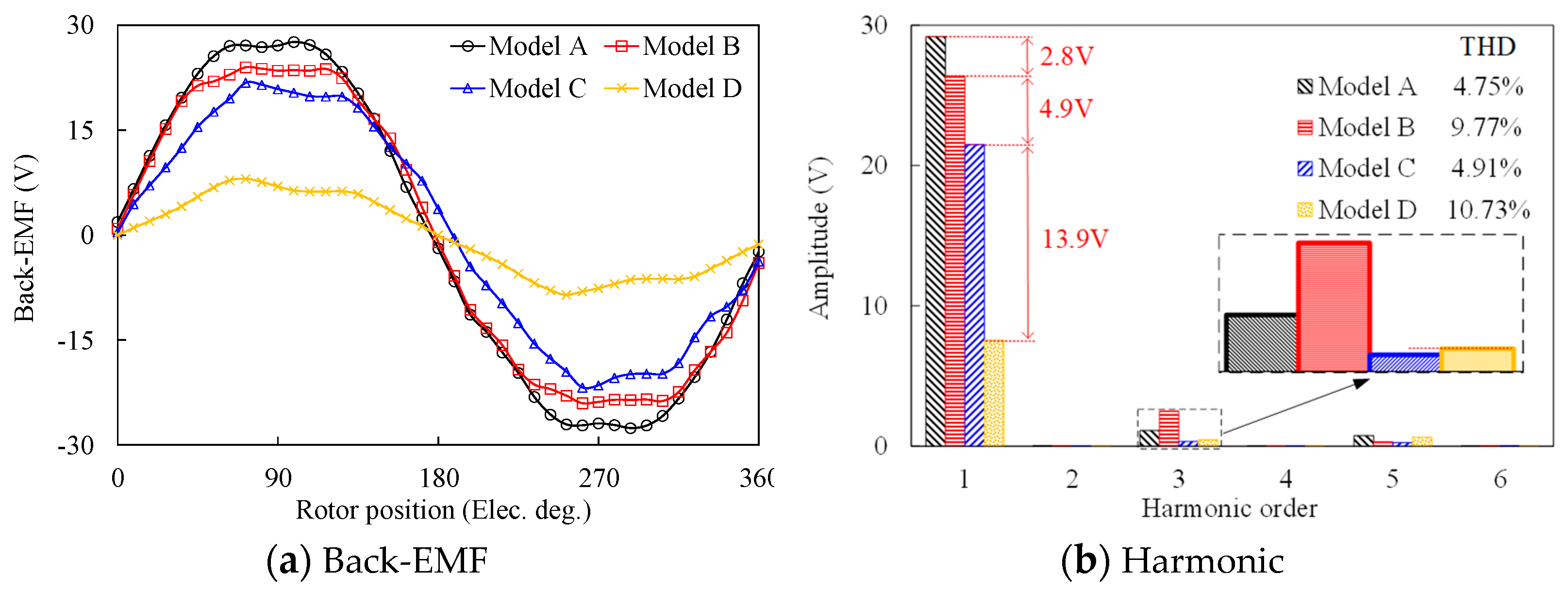
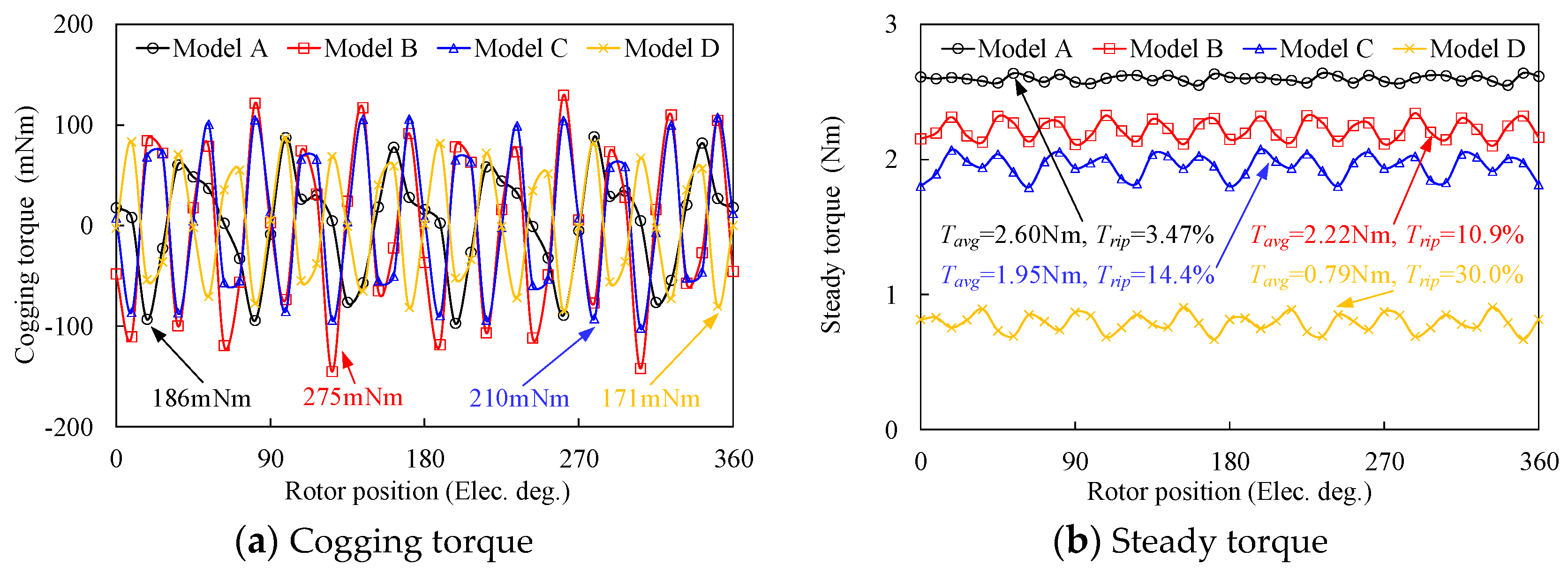
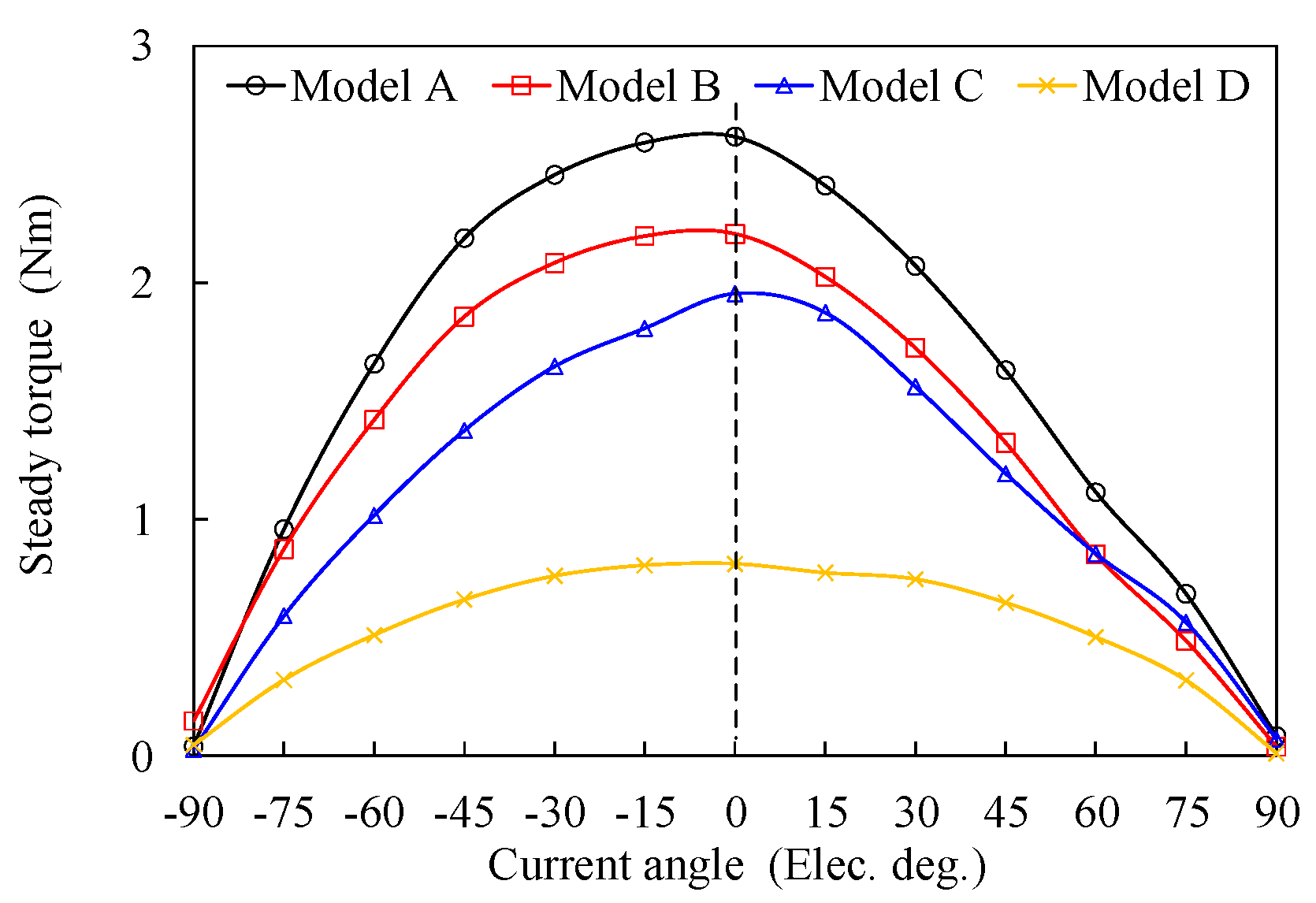
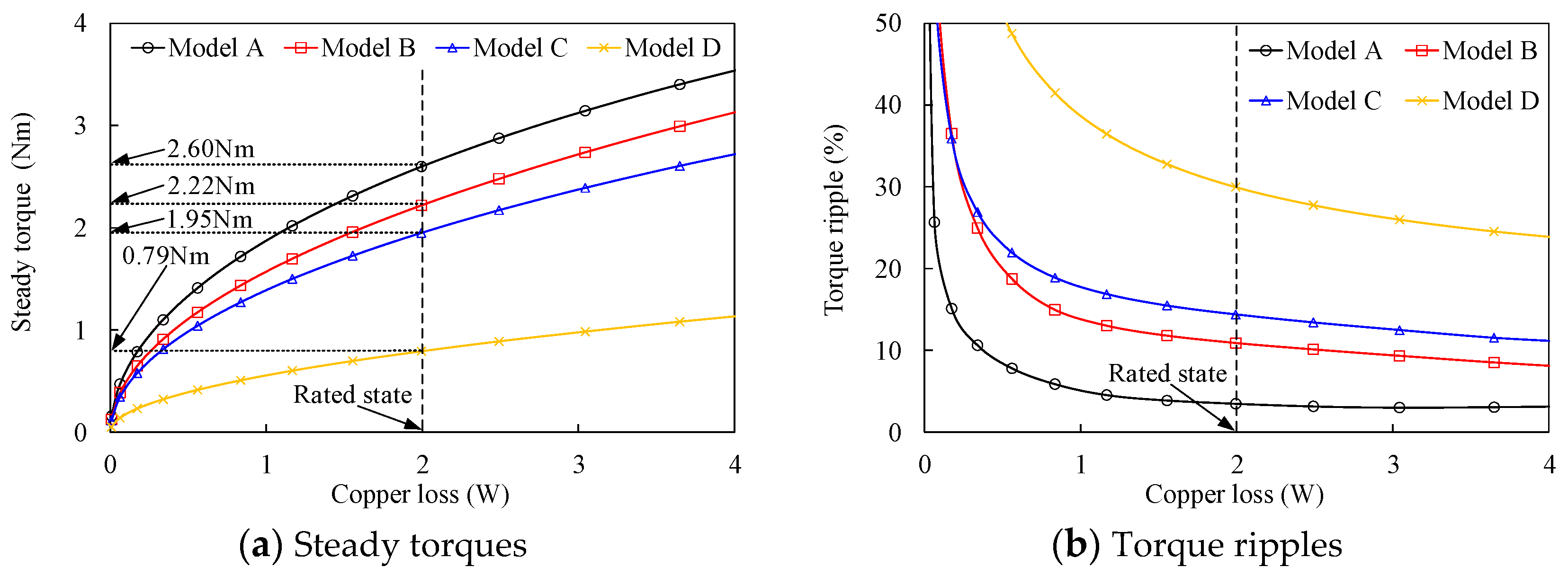

| Items | Model A | Model B | Model C | Model D |
|---|---|---|---|---|
| Stator slot number | 12 | |||
| Outer/inner diameter of outer stator (mm) | 140/103 | |||
| Outer/inner diameter of inner stator (mm) | 76/20 | |||
| Outer/inner diameter of rotor (mm) | 102/77 | |||
| Active length of inner/outer airgap (mm) | 0.5/0.5 | |||
| PPN of rotor | 11 | |||
| Turn of the inner/outer armature windings | 128/128 | |||
| the inner/outer slot area (mm2) | 95/152 | |||
| Active stack length (mm) | 20 | |||
| PPN of the inner/outer PM | 6/12 | 12/6 | 6/6 | 12/12 |
| PM volume (mm3) | 94.5 | |||
| PM grade | N38SH | |||
| PM remanence (T) | 1.28 | |||
| PM coercive force (kA/m) | 955 | |||
| Rated speed (rpm) | 273 | |||
| RMS value of rated current (Arms) | 1.7 | |||
| HR (mm) | 5 | |||
| θT (deg.) | 7 | 2 | 10 | 18 |
| Items | Model A | Model B | Model C | Model D |
|---|---|---|---|---|
| Amplitude of back-EMF (V) | 27.6 | 24.0 | 21.8 | 8.1 |
| THD of back-EMF (%) | 4.75 | 9.77 | 4.91 | 10.73 |
| Peak-to-peak cogging torque (mNm) | 186 | 275 | 210 | 171 |
| Steady torque at rated state (Nm) | 2.60 | 2.22 | 1.95 | 0.79 |
| Torque ripple (%) | 3.47 | 10.9 | 14.4 | 30.0 |
| Power factor | 0.91 | 0.90 | 0.75 | 0.67 |
| Output power (W) | 74.21 | 63.37 | 55.68 | 22.61 |
| Copper Loss (W) | 1.99 | 1.99 | 1.99 | 1.99 |
| Iron Loss (W) | 2.20 | 1.59 | 2.46 | 1.81 |
| Magnetic loss (W) | 0.26 | 0.08 | 0.08 | 0.29 |
| Efficiency (%) | 94.3 | 94.5 | 92.5 | 84.7 |
Disclaimer/Publisher’s Note: The statements, opinions and data contained in all publications are solely those of the individual author(s) and contributor(s) and not of MDPI and/or the editor(s). MDPI and/or the editor(s) disclaim responsibility for any injury to people or property resulting from any ideas, methods, instructions or products referred to in the content. |
© 2022 by the authors. Licensee MDPI, Basel, Switzerland. This article is an open access article distributed under the terms and conditions of the Creative Commons Attribution (CC BY) license (https://creativecommons.org/licenses/by/4.0/).
Share and Cite
Ding, Z.; He, C.; Feng, C.; Yang, J. A New Dual Stator Permanent Magnet Machine Based on Field Modulation Theory. Sustainability 2023, 15, 281. https://doi.org/10.3390/su15010281
Ding Z, He C, Feng C, Yang J. A New Dual Stator Permanent Magnet Machine Based on Field Modulation Theory. Sustainability. 2023; 15(1):281. https://doi.org/10.3390/su15010281
Chicago/Turabian StyleDing, Ziyang, Chao He, Chunmei Feng, and Jianfei Yang. 2023. "A New Dual Stator Permanent Magnet Machine Based on Field Modulation Theory" Sustainability 15, no. 1: 281. https://doi.org/10.3390/su15010281




